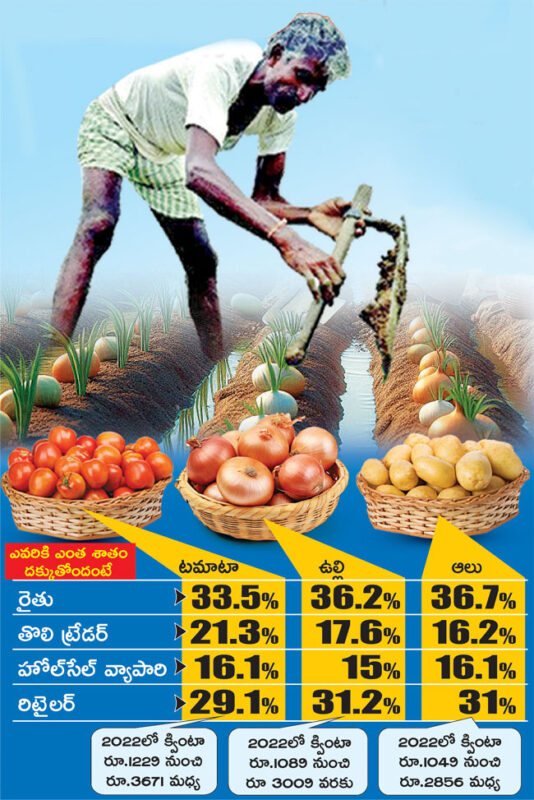The prices of tomato, onion and potato, which are used by people the most in the country, are currently skyrocketing in all the states. Consumers have to pay more for these. That means the farmers who are producing them should benefit greatly.
middlemen, 67% share of cost
goes to supplier, only 33%
Expert panel report to RBI on vegetable inflation
suggests to correct flaws in supply system
– HYDERABAD

The prices of tomato, onion and potato which are widely used by people in the country are currently sky high in all the states . Consumers have to pay more for these. That means the farmers who are producing them should benefit greatly. But, middlemen are making profits. The rice farmers who toil in both dry and rainy weather, endure natural calamities and sweat and harvest, get only 33 to 37 paise in rupees. In this context, a group of experts has conducted a study for the Reserve Bank of India (RBI) to find out what is happening from the farmer to the retailer on vegetable inflation. It submitted its report recently. It is published by the Department of Economic Policy Research. This report concluded that the farmer who is cultivating despite many tides is not getting even a third of the rupee. From 63 to 67 paise in the rupee…from the farmer in the form of commissions, transportation, loading, unloading and storage charges to traders, wholesalers, retailers who buy the produce in the agricultural market. Due to this, the prices are increasing…the burden is falling on the consumer. A team of experts has prepared this report on all aspects of tomato, onion, potato cultivation, production, transportation, storage, sales, prices, etc. from 2012 to 2022 from central and state governments, agricultural markets and wholesale markets. It pointed out the flaws in the supply system. It has been revealed that due to the lack of proper value chain from the time the produce reaches the hands of the farmer to the consumer, there has been an opportunity for the middlemen to steal. As a result, many developments are taking place from the farmer to the consumer. That means both the producer and the consumer are facing losses.
Alu… all are small farmers
The production of potato tubers was 48 million tonnes in 2014-15 and will reach 60.1 million tonnes by 2022-23. Cultivated area increased from 20.7 lakh hectares to 23.3 lakh hectares. Rabi accounts for 32% of the total production in Uttar Pradesh alone. West Bengal has 24%, Bihar 16% and Gujarat 7%. 86.7% of the growers are smallholder farmers. Business is done at cold storage plants in APMC markets. Farmers have to pay Rs.250 to Rs.260 per quintal for storage along with transportation and labor charges.

Rabi stocks are key in onion
Onion production increased from 18.9 million tonnes in 2014-15 to 30.2 metric tonnes by 2022-23. Cultivated area increased from 11.7 lakh hectares to 17.4 lakh hectares. Maharashtra and Gujarat account for 80% of the total onion production; Located in Rajasthan. 77% of the production comes in Rabi. Only rabi season onion can be stored. These reserves are very important in controlling inflation. The government collects it through NAFED and releases it when the crop is low. Cost per quintal yield of onion is lowest in Madhya Pradesh at Rs.341.07. The highest in Tamil Nadu is Rs.2305. In Andhra Pradesh it costs Rs.965.27. Onion is mostly bought by traders from farmers through open auction in APMC market. The labor charges and transport charges to the mandis have to be borne by the farmers. Traders procure through auctions with the help of commission agents. Mandi charges 1%, commission charges 4%, loading and unloading charges Rs.9.02 per quintal. Loss of packing and loss of weight is high. Such loss is 10% in Kharif and 5% in Rabi.
Onion exports are also high. 2.6 million tonnes were exported in 2022-23. It is 8.6% of the total production. It is mostly exported to Bangladesh, Nepal, Sri Lanka, Singapore and other countries. The export of tomato and potato is only two percent.

The tomato of Odidodukula
Tomato is grown mostly in Andhra Pradesh, Maharashtra, Karnataka, Gujarat, Tamil Nadu and West Bengal. 67% of the total production comes in Rabi. It is cultivated throughout the year in Andhra Pradesh, Madhya Pradesh and Gujarat. In West Bengal and Uttar Pradesh, the harvest is between November and January. Overall, the yield per hectare increased from 21.3 tonnes to 24 tonnes between 2014-15 and 2022-23. In Andhra Pradesh, the yield increased from 27.3 tonnes to 43.3 tonnes per hectare. Yields have declined in other major producing states. The members of the expert panel studied the retail prices of the sales during 2021-22 at Agmarket, Delhi. It has been found that the tomato farmer gets only 33.5% of the price paid by the consumer. That means if we get rupees per kg… the farmer gets only 33.5 paise. This includes transportation and labor charges. Addition of farmer’s labor



